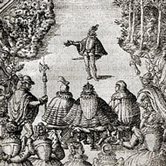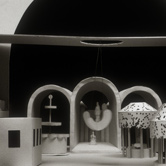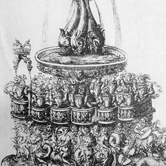From: Woodruff, Dianne L. “The Balet Comique in the Petit Bourbon: A Practical View.” 1986.
[Let me begin by stating my regret for having failed to make clear to Dianne’s audience that awkward as Patin’s perspective drawing of La Salle seems, his schema managed to communicate the greatest possible amount of visual information from the end of so long a hall. Further to this, no perspective drawing can render dimensions since its purpose is only to simulate our stereoscopic vision; rather, that is the purpose of isometric, orthographic and section drawings.]
Excerpted from the section: “The Maquette: A Working Model, Scale ¼” = 1’-0””
“The shapes were deliberately generic to enhance their purpose: to seek an understanding of proportion and scale of the elements within” (VCK).
The fountain (see Figs. 10A and 10B) was sculpted first because it was the most fully documented element. The documentation included the image in the etching and the detailed description including dimensions by Beaujoyeulx. Unfortunately the MacClintock translation of the passage contains several serious errors which are confusing to the researcher or model maker. The text describes three basins with a ball on the top but the description of the bottom one did not make sense” (VCK). Kaelin went back to the original text and came up with a very different translation that shows how working practically can assist in the understanding of the words. If MacClintock had been trying to build the fountain, she would not have stopped with this version:
‘above this basin was an edging, projecting one foot, and another small basin was formed by this projection, large enough, however to receive the whole decoration of the fountain’ (p. 47).
Kaelin’s translation of this passage reads: below this basin was a one foot sill of turbulent water, and this sill itself served as another small basin which thus served as a means of receiving the whole decoration of the fountain.”
“In other words, although the first main basin measured 12’-0” in diameter, it rested in turn on a base of a shallow bowl which represented the sea and from which the elaborate carvings of sea creatures on the side of the basin seemed to emerge. This basin projected a foot beyond the circumference of the basin and according to the text further on, the front extended 6’-0” forward in order to accommodate the sea horses or ‘hippopotami’ that appear to be pulling this aquatic chariot. In toto, then the machine, which today we would call a float or a wagon, would have been 14’-0” wide and 19’-0” long, just narrow enough to squeeze through the side trellis which was 15’-0” wide, for its entrance and exit” (VCK).
“We surmised, likewise that given the probability of such an entrance, the fountain could not exceed the height of the trellis, 24’-0”. Indeed, in our study of ratios, the model fountain measures 20’-10” in scale to the top of the sphere, not counting the little banner at the top. Including the banner, the wagon measures 22’-5” ” (VCK).
“In relating the dimensions of the sphere crowning the top of the fountain, the MacClintocks perhaps fall prey to their desire for consistency since all the other round shapes are described by diameter. They translate the sphere as being five feet in diameter which raises the question as to how water could fall from it into the basin below, which is four feet in diameter. The diameter of that sphere, we found to be its circumference divided by pi. Indeed, Beaujoyeulx writes: Y avoit une grosse boule de cinq pieds de rondeur en sa circonference (Lacroix 1 :37). “The redundancy of expression characteristic of sixteenth century French should have served as ample emphasis with which to alert the translator of the switch from diameters to circumference. Stylistically it is also awkward to state that the sphere was 1.59323566 feet or even 1’-6” in diameter (VCK).
“Henceforth the etchings of the individual pieces were examined carefully for the truth contained within the graphic conventions of that period and of the eccentricities of translation or artist” (VCK).
The fountain, in a sense, became the most immediate reminder of the scale of the production, all the more so, since the author states that twelve women were accommodated in the seating in the first basin and names them all” (VCK).

Patin, Jacques. “Figure de la Salle.” Le Balet Comique de la Royne, 1581. Published 1582. This plate is reproduced in thumbnail by several commercial print companies on line. |

Kaelin, Valérie and Beverly Zawitkoski. «Figure de la Scène, Le Balet Comique de la Royne, 1581. » Feather Grey Peterborough Paper Maquette. ¼” = 1’-0” 1986; In Woodruff, Dianne L. et al. “The Balet Comique in the Petit Bourbon: A Practical View (Fig. 14B).” York University Faculty of Fine Arts Dance Colloquium I, 19 November 1986. |

Patin, Jacques. Printed by Ballard in Balet comique de la Royne, faict aux nopces de Monsieur le Duc de Joyeuse & madamoyselle de Vaudemont sa sœur. Par Baltasar de Beaujoyeulx, valet de chambre du Roy, & de la Royne sa mere ; Fichier:Fountain chariot from the Ballet Comique de la Reine, 1581.jpg ; in Contributeurs de Wikipédia, "Présence italienne en France," Wikipédia, l'encyclopédie libre, (Page consultée le décembre 27, 2012). |

Kaelin, Valérie and Beverly Zawitkoski. « Chariot de la Fontaine, Le Balet Comique de la Royne, 1581. » Feather Grey Peterborough Paper Maquette. ¼” = 1’-0” 1986; In Woodruff, Dianne L. et al. “The Balet Comique in the Petit Bourbon: A Practical View (Fig. 10A).” York University Faculty of Fine Arts Dance Colloquium I, 19 November 1986. |

Kaelin, Valérie and Beverly Zawitkoski. «The Fountain Emerging from the Trellis, Le Balet Comique de la Royne, 1581. » Feather Grey Peterborough Paper Maquette. ¼” = 1’-0” 1986; In Woodruff, Dianne L. et al. “The Balet Comique in the Petit Bourbon: A Practical View (Fig. 13).” York University Faculty of Fine Arts Dance Colloquium I, 19 November 1986. |

Kaelin, Valérie. “Ground Plan #2: Le Balet Comique de la Royne.“ 1986; In Woodruff, Dianne L. et al. “The Balet Comique in the Petit Bourbon: A Practical View (Fig. 9).” York University Faculty of Fine Arts Dance Colloquium I, 19 November 1986.. |
A full transcript of the article by Dianne L. Woodruff, PhD:
Availabitlity for purchase under consideration.
Contact us for more information
^ back to top of the page
To Cite this Page
| CMS |
“Excerpts from ‘The Maquette: A Working Model, Scale ¼” = 1′-0″’” (Valérie C. Kaelin); In Woodruff, Dianne L. “The Balet Comique in the Petit Bourbon: A Practical View.” Toronto: 1986.” Valérie C. Kaelin Website; Scenography; Theory; December 24, 2012; Accessed Month, Day,Year. http://www.valeriekaelin.com.
|
| MLA |
“Excerpts from ‘The Maquette: A Working Model, Scale ¼” = 1’-0″’” (Valérie C. Kaelin) from “The Balet Comique in the Petit Bourbon: A Practical View.” Written by Dianne L. Woodruff. Toronto: 1986. Valérie C. Kaelin Website; Scenography; Theory; 13 Dec. 2012. Web. Add Day, Abbreviation for Month, Year. |
|

